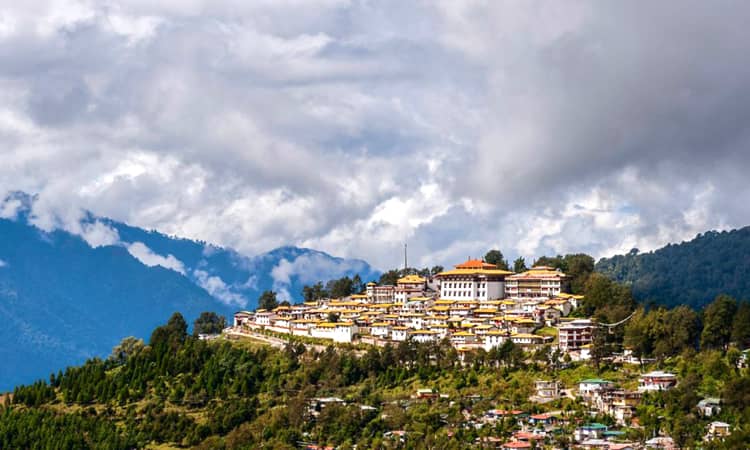Tawang Monastery is a magnificent Buddhist monastery located in the state of Arunachal Pradesh in Northeast India. It is one of the largest monasteries in the world and holds immense religious and cultural significance for Buddhists. Tawang Monastery, also known as Galden Namgyal Lhatse, is perched atop a hill at an altitude of approximately 10,000 feet, offering breathtaking views of the surrounding valleys and snow-capped mountains. Let’s delve into the captivating details of Tawang Monastery and explore its rich history, architecture, festivals, and more.

Facts about Tawang Monastery:
- Tawang Monastery is believed to have been founded by Merak Lama Lodre Gyatso in the 17th century, making it over 400 years old.
- It is the largest monastery in India and the second-largest in the world, only after the Potala Palace in Lhasa, Tibet.
- The monastery is affiliated with the Gelug school of Tibetan Buddhism and follows the teachings of Tsongkhapa, the founder of the Gelugpa sect.
- Tawang Monastery is home to more than 450 monks and is an important centre for Buddhist learning, meditation, and rituals.
Location of Tawang Monastery:
Tawang Monastery is located in the district of Tawang in the state of Arunachal Pradesh, India. It is situated close to the India-China border and is surrounded by picturesque landscapes, including snow-capped mountains, lush green valleys, and sparkling lakes.
Legends associated with Tawang Monastery:
According to local legends, Tawang Monastery is considered a sacred site blessed by the great Buddhist master, Guru Padmasambhava, also known as Guru Rinpoche. It is believed that Guru Rinpoche meditated in the caves around Tawang, bestowing his blessings upon the land and its people. The name “Tawang” is said to be derived from “Ta” meaning horse and “Wang” meaning chosen, reflecting the legend that Guru Rinpoche’s horse was found at this location.
History of Tawang Monastery:
Tawang Monastery has a fascinating history that dates back several centuries. It was established in 1680-1681 by Merak Lama Lodre Gyatso, a disciple of the fifth Dalai Lama, Ngawang Lobsang Gyatso. Since its inception, the monastery has played a vital role in preserving and propagating Buddhist teachings in the region. Over the years, Tawang Monastery has faced several challenges, including invasions and destruction during the turbulent times of history, but it has managed to survive and thrive.
Architecture of Tawang Monastery:
The architecture of Tawang Monastery is a splendid blend of Tibetan and Indian influences. The monastery complex is built in a traditional Tibetan style, with towering walls, ornate gateways, and colourful prayer flags fluttering in the wind. The main assembly hall, known as the Dukhang, is the focal point of the monastery and houses a massive golden statue of Lord Buddha. The walls of the assembly hall are adorned with exquisite murals depicting scenes from Buddhist mythology and the life of Lord Buddha. The monastery also features numerous other buildings, including residential quarters for monks, libraries, and prayer halls.
Festivals at Tawang Monastery:
Tawang Monastery comes alive during festivals when devotees from far and wide gather to celebrate and seek blessings. The most significant festival is the Tawang Festival, held in the month of October, which showcases the rich cultural heritage of the region through dance, music, traditional attire, and vibrant processions. Another important festival is Losar, the Tibetan New Year, celebrated with great enthusiasm and spiritual fervour. During these festivals, monks perform Cham Dances, a traditional masked dance form, depicting various aspects of Buddhist mythology.
Places to Stay near Tawang Monastery:
There are several accommodation options available near Tawang Monastery, ranging from budget guesthouses to mid-range hotels. Some popular places to stay include Tawang Inn, Hotel Dondrub, Hotel Tawang Heights, and more. It is advisable to book in advance, especially during peak tourist seasons, to ensure a comfortable stay.
Best Time to Visit Tawang Monastery:
The best time to visit Tawang Monastery is during the summer months from April to June when the weather is pleasant and the region is accessible. The monsoon season from July to September should be avoided due to heavy rainfall and landslides. Winter months from November to February bring heavy snowfall, making it challenging to reach Tawang, but if you are a fan of snow and want to witness the mesmerizing winter landscapes, this can be an option.
How to Reach Tawang Monastery:
Reaching Tawang Monastery can be an adventurous journey due to its remote location. The nearest airport is Tezpur Airport in Assam, approximately 320 kilometres away. From the airport, one can hire a taxi or take a shared cab to Tawang. Another option is to reach Guwahati, the largest city in Assam, and then take a bus or taxi to Tawang.
The nearest railway station to Tawang is Tezpur Railway Station, which is well-connected to major cities in India. From Tezpur, one can hire a taxi or take a bus to Tawang. However, it is important to note that the road journey from Tezpur to Tawang can be long and challenging due to the hilly terrain and narrow roads.
For those who prefer road travel, Tawang is accessible via the Sela Pass, which offers breathtaking views of the snow-clad mountains and frozen lakes. It is advisable to hire a local driver or take a guided tour to navigate through the challenging mountain roads.
In conclusion, Tawang Monastery is a remarkable Buddhist monastery nestled amidst the scenic landscapes of Arunachal Pradesh. With its rich history, awe-inspiring architecture, and vibrant festivals, Tawang Monastery offers a unique spiritual and cultural experience. Visiting this sacred site allows one to immerse themselves in the tranquillity of Buddhist teachings and witness the beauty of the Himalayan region.
Suggested Tours
